Philly Part 2
Click on the first photo in each group and scroll to see the square photos at full size.
To start at the beginning of this series, visit Chocolate and So Much More
This post continues our road trip to Philadelphia, PA during our family vacation to Hershey. After lunch at the Hard Rock, we hopped back on the Phlash Bus and headed back where we started – the Independence Visitor Center – and began the next part of our tour of the City of Brotherly Love. We started off with a short walk to Christ Church.
“The very existence of Christ Church and the elegant majesty of this building is a testament to the success of William Penn’s “Holy Experiment.” His Charter of Privileges allowed all denominations freedom of worship, even the Church of England from which Quakers had dissented on their native soil.
Today, Christ Church is often called “The Nation’s Church,” and its history is closely tied to that of colonial Philadelphia and the birth of America. George Washington, Benjamin Franklin and Betsy Ross all worshipped here, along with 15 signers of the Declaration of Independence and other patriots, though many Loyalists were counted among its members as well.” – READ MORE on the plaque below right.
“The original church structure was a small brick and wooden structure that fit into its Quaker-dominated surroundings in the late 1600s. The current church was started in 1727, and has long been considered one of the finest Georgian structures in America. The steeple, financed by a lottery organized by Benjamin Franklin, was the tallest structure in the colonies for 56 years.
The interior of the church is as impressive as the exterior. It includes the baptismal font from the 1300s donated by All Hallows Church London in which William Penn was baptized, a pulpit from 1769 built by Thomas Folwell and a chandelier still in use since its installation in 1740.” – READ MORE about Christ Church
This was a beautiful place, with guides to provide information and answer questions. Since the Betsy Ross House was coming up on our tour, our granddaughter asked if Betsy had attended this church and the guide showed us her pew. Located on the other side of the post in the photo above top-right, the view was somewhat obstructed but close to the front. Knowing the first president of the United States was also a parishioner here, made it very exciting for everyone. Click here for more history about Christ Church.
There was a nice garden area outside with benches to sit and contemplate the intensity of the times. Several gravestones of folks associated with the church are part of the walkway at the entryway. Several more are in the garden in the back, including Jacob Broom who was a signer of the Constitution – picture above left.
Elfreth’s Alley
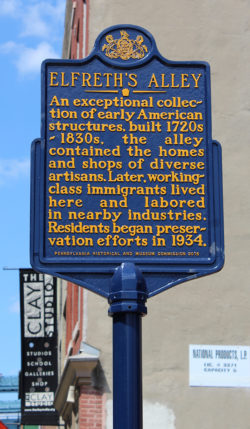
As Philadelphia became a large and bustling city in the early 1700s and artisans and other merchants acquired property close to the ports where goods arrived, this alternate route to the Delaware River was opened. Starting as a cart path in 1706, Elfreth’s Alley has become “our nation’s oldest residential street” and was named after silversmith Jeremiah Elfreth.
“Nestled between Second Street and the Delaware River, thirty-two Federal and Georgian residences stand as reminders of the early days of Philadelphia. Designated a National Historic Landmark October 15th, 1966.” – Click for more information and great photos of Elfreth’s Alley – both past and present.
The Betsy Ross House
Although I got no photos of the exterior of her house, I did get a nice photo of “Betsy Ross” herself! She was there to answer any questions about her life and did say that – as of that time, she had not yet received payment for creating the first stars and stripes flag, but she was hopeful that she would. She understood, because they were a little busy fighting a war and all.
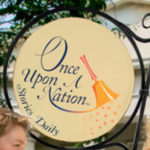 While at Betsy’s house, we stumbled upon a wonderful little activity for the kiddos, and we enjoyed it too. Unfortunately we discovered it towards the end of our day, so we didn’t hear all of the stories, which would have been a goal had we known about them earlier. We all love to hear stories on tours, as they make the whole event a little more real and memorable.
While at Betsy’s house, we stumbled upon a wonderful little activity for the kiddos, and we enjoyed it too. Unfortunately we discovered it towards the end of our day, so we didn’t hear all of the stories, which would have been a goal had we known about them earlier. We all love to hear stories on tours, as they make the whole event a little more real and memorable.
“On select days throughout the summer, costumed historians at 13 storytelling benches throughout Historic Philadelphia entertain visitors with short and entertaining anecdotes about the Colonial era as part of Once Upon a Nation. Children can pick up a Story Flag at any storytelling bench, then collect a star from every storyteller on their journey. Flags with all the stars can be redeemed for a History Hero Certificate and a free carousel ride on the Parx Liberty Carousel at Franklin Square.” – READ MORE about the Once Upon A Nation stories and other fun things for kids in Philadelphia
Apparently, there is some controversy as to the validity of the entire Betsy Ross story, according to USHistory.org in the quote below, which says there’s no hard evidence that it actually happened. Maybe had they paid her for her services, there would have been a paper trail!
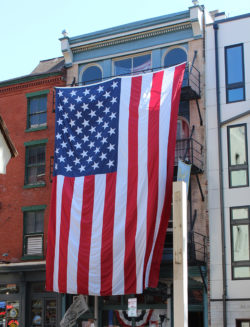 “While any individual U.S. flag is physically no more than a piece of fabric emblazoned with stripes and stars, it remains a poignant symbol of our nation, and symbols have inspired and united people for centuries.
“While any individual U.S. flag is physically no more than a piece of fabric emblazoned with stripes and stars, it remains a poignant symbol of our nation, and symbols have inspired and united people for centuries.
Betsy Ross is herself a symbol. The story of the humble seamstress creating a flag for the emerging nation is a treasured national legend. But she was more than just a legend. Betsy was a real historical figure and a subject of ongoing research and inquiry. Her story would remain inspirational regardless of whether additional evidence emerges to corroborate it, but we should not be at all surprised if it does.
Why would Betsy Ross be chosen to make the flag? It was usual in that day for upholsterers to be flagmakers. As Betsy Ross prayed in the pew next to George Washington and had already sewn buttons for him, and she was a niece of George Ross, it is not exceptional that these members of the Flag Committee formed by the Continental Congress would call upon Betsy Ross to make the flag.” – READ MORE about Betsy Ross
There’s a whole lotta flag-waving going on in Philadelphia! The flag above was hanging across the street from Betsy’s house, probably as a tribute to a job well done!
Historic Arch Street Quaker Meeting House
“Let there be sacred silence. Upon entering this Meeting House for the first time, a visitor unfamiliar with Quaker practices beholds a room with no pulpit; sunbeams rolling in but not through stained-glass windows; no religious icons hanging from the walls; no shrines are to be found at all. Instead, one steps into a great, square room filled with row after row of wooden pews, from all sides facing the center. A balcony supported by Doric columns spans three sides of the room. Plain are the windows and shutters; the floor is of unvarnished wood. Dominant colors: brown, white. Simple. Silent.
Quakers, also known as the Society of Friends, have no written creed or fixed tenets of belief and no defined program of prayer. Music and sermonizing are absent during Worship Meetings. Further, Worship Meetings do not have a person in charge. Rather, Friends believe that God resides in each individual. Congregants enter the Meeting Room and settle down in silent waiting. Any Friend who feels the “light” may share a message or prayer with others. In this room one is reminded of the words of the poet Marianne Moore, “The deepest feeling always shows itself in silence.” – READ MORE about the Arch Street Friends Meeting House
Yet another good place for a break!
Next up: Philly Finale!
Happy trails,
Barb

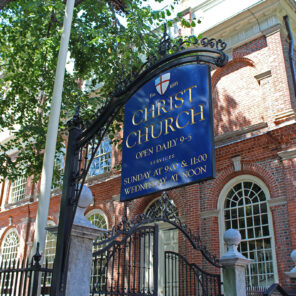

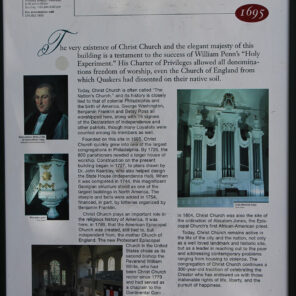
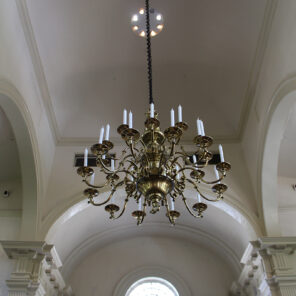
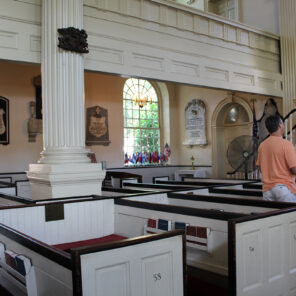
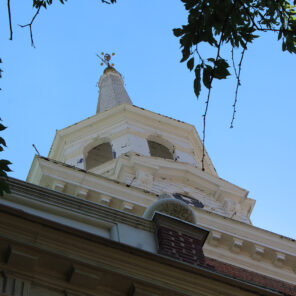

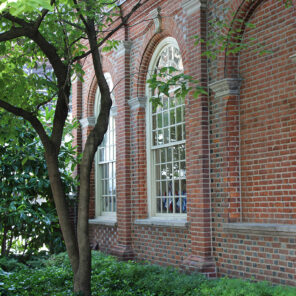
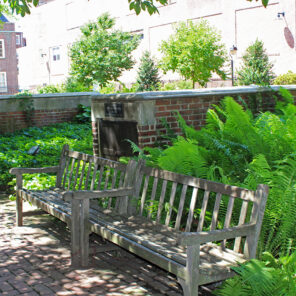
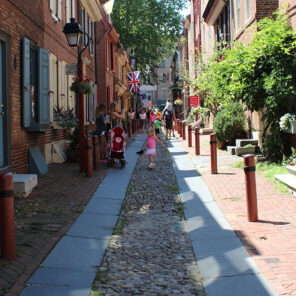
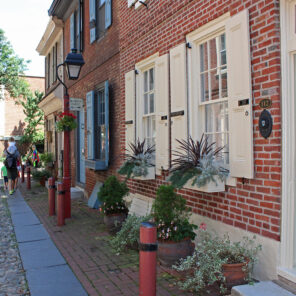
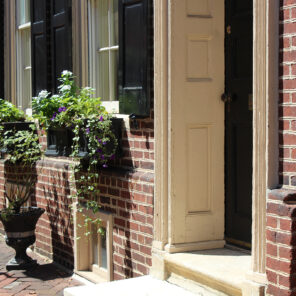
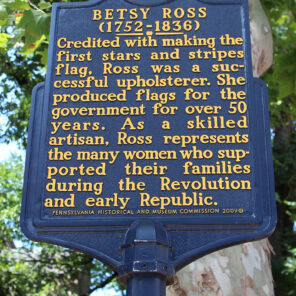
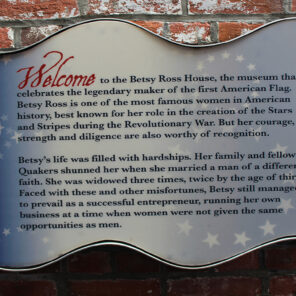
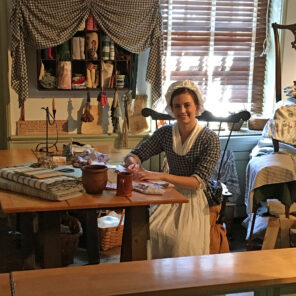
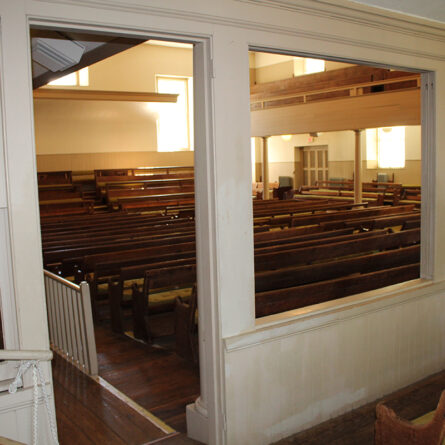







Comments are closed here.